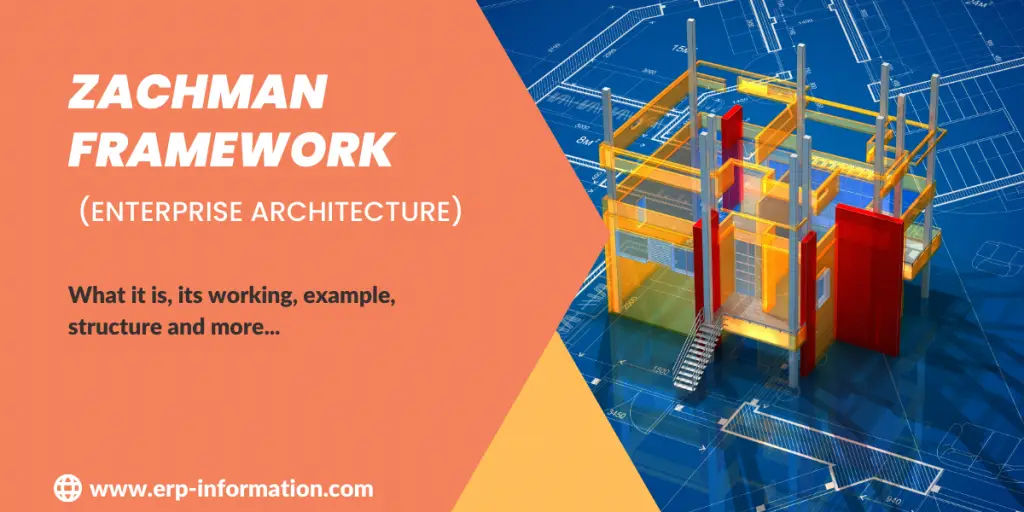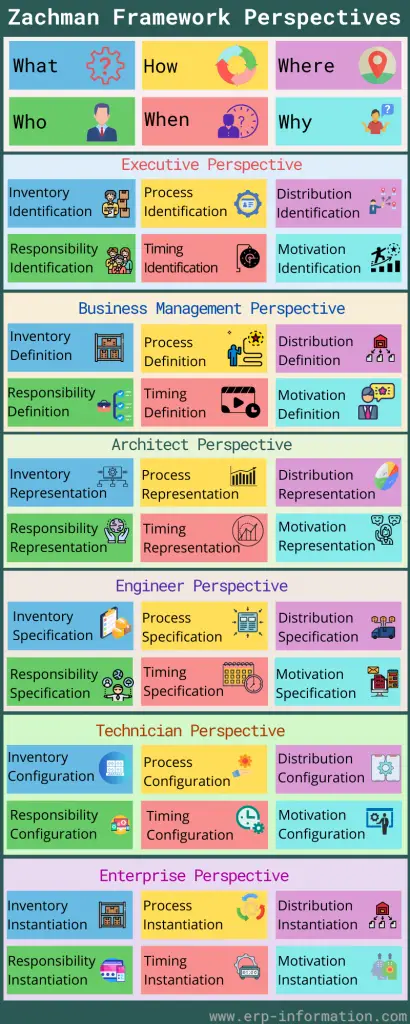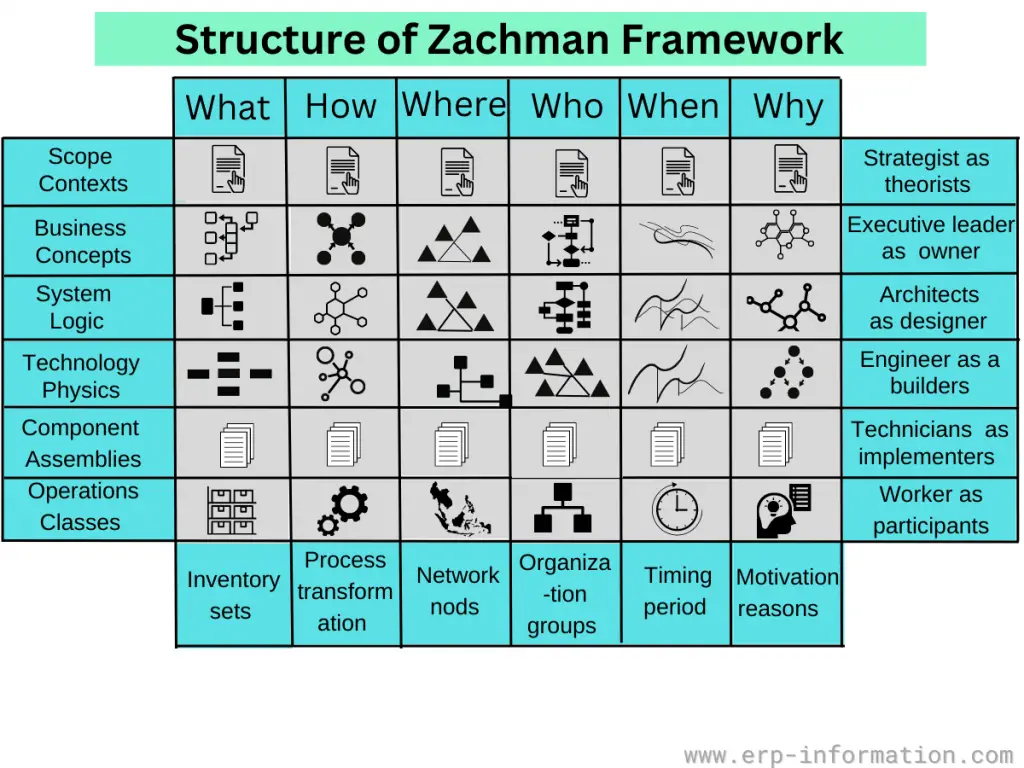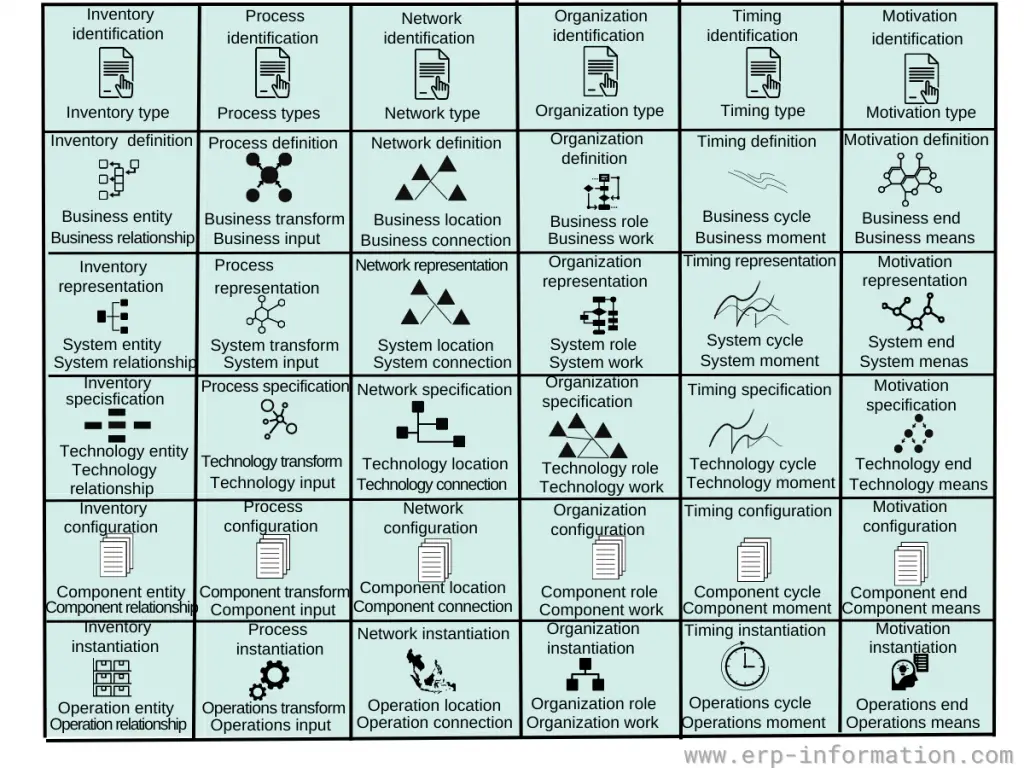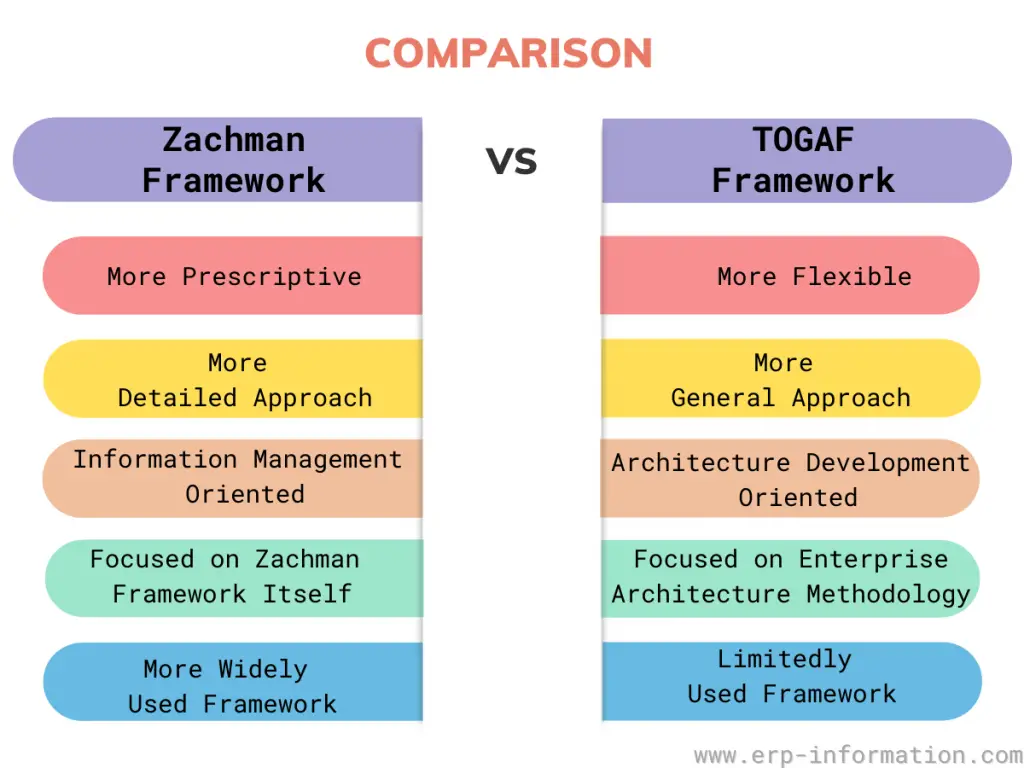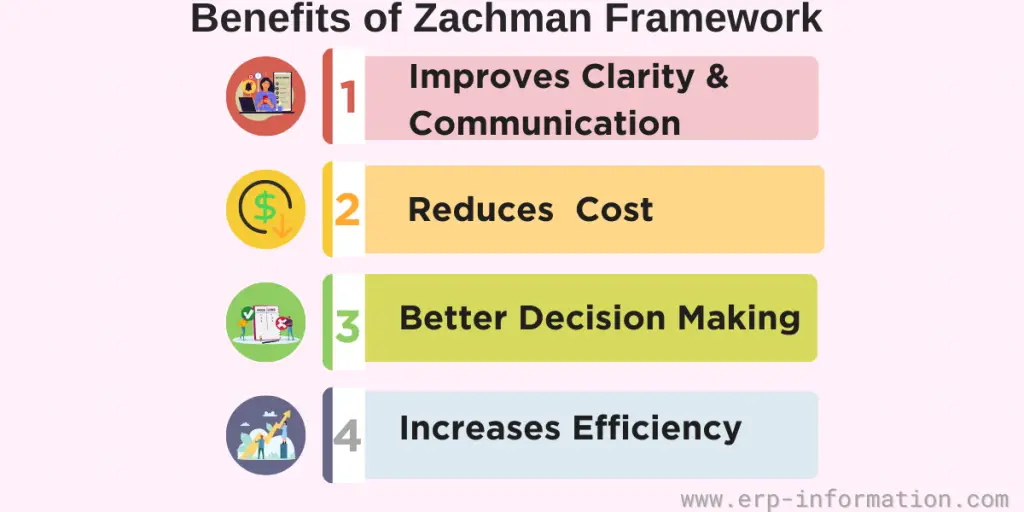Aligning the strategic objectives with IT systems is very important for success. This alignment is the essence of Enterprise Architecture (EA), a discipline designed to structure business processes and ensure they are in harmony with IT.
Among the various tools available for this purpose, the “Zachman Framework” stands out as a cornerstone of Enterprise Architecture.
The Zachman Framework’s role as an ‘Ontology’ in enterprise architecture offers a unique and invaluable perspective. It’s not about telling you how to do things, but about helping you understand what needs to be done and why.
It helps to clarify how different parts of a business interact and depend on each other, providing a blueprint that ensures all aspects of the enterprise work cohesively.
This blog post will discuss the Zachman Framework, its working, its examples, its benefits, and how you can use it to improve your organization’s architecture.
What is Zachman Framework?
John Zachman created this framework in late 1984s, becoming the most widely accepted framework for enterprise architecture. It provides a structure for organizing information about an organization’s business, processes, data, applications, and technology.
The Zachman Framework is a tool that helps businesses organize and understand how different parts of their organization work together. Think of it as a blueprint that shows everything from the big picture to the tiny details of how a business operates and uses its technology.
It helps everyone in the company see how their work fits into the larger goals and how it connects with other parts of the business. This makes it easier for businesses to make sure everything runs smoothly and that their technology supports their goals effectively.
With the Zachman Framework, businesses can better plan their strategies and make smarter decisions, making sure all parts of the business are moving in the same direction.
Difference Between Ontology and Methodology
| Ontology | Methodology |
| In information science, an ontology provides a structured way to represent the properties of a subject area and the relationships between those properties. Think of it as a blueprint or a detailed model of all the components that make up an enterprise and how they interconnect. The Zachman Framework is precisely this a comprehensive schema for understanding and documenting an enterprise’s architecture. | It’s a process or a series of steps designed to change something from one state to another. In business terms, methodologies guide you through the sequences of actions required to achieve certain goals, like developing software, managing projects, or implementing business strategies. |
How Does It Work?
It divides enterprise architecture into six domains. They are
- Business
- Data
- Process
- Application
- Infrastructure
- Technology
Each domain is further divided into sub-domains.
For example, the business domain includes goals and objectives, strategy execution, value chain, and customers.
It is based on the idea that organizations should be able to answer two questions about any aspect of their business: “What does it do?” and “How does it do it?” Therefore, the framework provides a structure for organizing information to find answers to these questions.
The two parts of it:
- The fact model incorporates consumers, suppliers, products, and services.
- A design model shows how these facts are represented within an organization’s systems.
This uses rows to represent different perspectives or viewpoints on enterprise architecture (e.g., strategic planning vs operations). In addition, columns represent artifacts created during system development (e.g., requirements specifications or process flows).
It collects information related to one viewpoint and artifact type pair. As a result, it provides answers to both questions (“What does it do?”) and (“How does it do it?”). This helps businesses understand specific areas of their work.
Detailed Structure
Imagine the Zachman Framework as a detailed blueprint of a building, but instead of showing just the physical structure, it maps out everything that makes an enterprise function smoothly.
This blueprint is laid out in a matrix form, making it easy to see how different parts of your business relate and interact.
What Makes Up the Matrix?
The Zachman Framework matrix has 36 cells, each focusing on a unique aspect of your organization. All these 36 cells are organized into rows and columns, each offering a distinct perspective:
Rows
Think of each row as a different floor in a building, where each floor represents a viewpoint from various stakeholders involved in developing business systems. These include everyone from top-level planners to the everyday users of these systems. Such as
- Scope contexts (Planner’s view) – Represents business purpose and strategy.
- Business concepts (Owners view) – Represents the part of the enterprise that can be automated.
- System logic (Designers’ view) – This represents how the system fulfills the business’s information needs.
- Technology physics (Implementer’s view) – Represents how the system will be implemented.
- Component assemblies (Sub-contractors view) – Represents the implementation-specific details.
- Operations classes (Users view) – Represents the functioning of the system.
Columns
Each column is like a different beam supporting the structure, representing different questions about your business that stakeholders might ask.
These questions are the fundamental “What (data),” “Where (network),” “Who (people),” “When(time),” “Why (motivation),” and “How (function)” (W5H) that help define every detail of your enterprise.
Zachman Framework Example
The below example provides a structure for organizing information about an organization’s business, processes, data, applications, and technology.
Zachman Framework Template
Zachman vs TOGAF?
Zachman and TOGAF are two of the most famous enterprise architecture frameworks. But which one is right for your business?
Here is a comparison table to help you decide.
While both frameworks have advantages, The answer depends on your business needs. For example, the Zachman Framework is better for businesses that need to model their entire enterprise, while TOGAF is better for businesses that need a more general overview of their architecture.
Zachman Certification & Training
For enterprise architects aiming to deepen their expertise and stand out in the competitive field of Enterprise Architecture (EA), the Zachman Certified – Enterprise Architect Program is an invaluable asset.
Levels of Certification
The Zachman certification program is structured into four progressive levels, each designed to enhance your understanding and application of the Zachman Framework in real-world scenarios:
- Enterprise Architect Associate (Level 1): Start your journey by building a solid foundation in the basic principles of the Zachman Framework.
- Enterprise Architect Practitioner (Level 2): Dive deeper into the practical aspects of applying the framework to complex enterprise architectures.
- Enterprise Architect Professional (Level 3): Achieve mastery over the nuances of the framework and learn to manage large-scale architectural projects.
- Enterprise Architect Educator (Level 4): Prepare to teach and spread knowledge about the Zachman Framework, shaping the next generation of enterprise architects.
Why Choose Zachman Certification?
The Zachman Certified program is more than just an educational pursuit. It’s a gateway to career advancement, offering numerous benefits:
- Professional Recognition: This certification may enhance your professional stature in the field of enterprise architecture.
- Career Opportunities: Open doors to advanced career opportunities. In many high-level EA roles, a Zachman Certification is often in conjunction with TOGAF certification.
- Broader Perspectives: Learn to approach enterprise architecture from multiple dimensions and perspectives, making you a more versatile and effective architect.
Zachman Framework Benefits
Clarity and Structure
The framework provides a clear and structured way to understand, communicate, and manage complex enterprise architecture. It breaks down the intricacies of an organization into a grid-like structure, making it easier to visualize.
Universal language
It offers a universal language for discussing enterprise architecture. Regardless of your role within an organization, using the Zachman Framework helps ensure everyone is on the same page when discussing complex systems.
Holistic view
It encourages a holistic view of the enterprise. Instead of just focusing on IT, it forces organizations to consider the entire spectrum, including people, data, processes, and technology.
Increased efficiency
By categorizing different aspects of the enterprise, the framework can help identify gaps and overlaps in the architecture. This can lead to better problem-solving and enhanced efficiency.
Historical perspective
The framework allows organizations to maintain a historical perspective. Over time, they can track changes and the evolution of their architecture, which is valuable for learning and continuous improvement.
Zachman Framework Challenges
Complexity
The Zachman Framework can be quite complex to implement. It involves creating and maintaining detailed documentation, which can be time-consuming and resource-intensive.
Overhead
The comprehensive nature of the framework can result in information overload. Organizations might get lost in the details, making it challenging to prioritize and focus on critical issues.
Lack of guidance
The framework offers a structure but doesn’t provide specific guidance on how to implement enterprise architecture solutions. It’s more about “what” to do, rather than “how” to do it.
Lack of popularity
The Zachman Framework lacks popularity within the development community, with minimal awareness among developers.
Companies that Use the Zachman Framework
Both the Government and commercial sectors use the framework. In addition, many companies use the framework. Here we listed some of the familiar companies.
Commercial
- Aerospace Corporation
- Accenture
- Boeing
- BMC Software
- Dell
- East bank technologies
- IBM
- Deloitte
- Gartner Group
- Oracle
- Samsung
Government
- Airforce US PACOM
- National park service
- NASA centers
- US commerce department
- White House – EOP
- US Forrest service
- US postal service
- NASA HQ
- National defense university
Brief History of Zachman Framework
The Zachman Framework has evolved significantly since its inception by John A. Zachman in 1984. Initially developed as a simple three-column framework for information systems architecture at IBM, it quickly gained recognition for its clarity and utility.
By 1987, it was officially published in the IBM System Journal, marking its formal introduction to the wider industry. In 1992, the framework was refined to emphasize not just the construction, but the engineered integration of strategy and information systems across the enterprise, earning it the name “Zachman Framework.”
Over the years, the framework expanded in complexity and depth. In 2001, after a decade of development, a six-row version was released, broadening its applicability and recognition in the field of enterprise architecture.
2002 saw another significant revision, developed in collaboration with the Intervista Institute in Canada. This version introduced a distinctive design element, a black-to-white gradient, symbolizing the transformational rather than merely detailed nature of navigating the framework’s matrix.
Despite some dissatisfaction and subsequent revisions in 2003, including a return to earlier notations, the framework continued to evolve. In 2004, the Zachman Framework 2 was introduced with a focus on more business-oriented terminology, enhancing its relevance to general management.
The most recent major update came in 2011, after John Zachman and Zachman International consulted with leading experts to refine the framework. This version represents a culmination of over 40 years of evolution, reflecting a deep and comprehensive understanding of enterprise architecture.
Today, the Zachman Framework remains a foundational tool in enterprise architecture, helping organizations around the world structure and understand their operations more effectively.
FAQs
What is the rule of the Zachmen framework?
Alignment: Each cell in the Zachman Framework should fit together like pieces of a puzzle. This means that every cell should make sense in relation to the cells directly above and below it. It’s like building a structure where each part supports the parts above and below it.
Uniformity: In each row of the framework, all the cells should be consistent with one another. This means that the information in each row should be related and work together to provide a complete description of the organization from a specific perspective.
Uniqueness: Each cell in the Zachman Framework is different and serves a unique purpose. They don’t repeat the same information, and each one has its own specific role in describing the organization.
Completeness: When you combine all the cells in one row, you get a full and detailed view of the organization from a particular angle. It’s like putting together a puzzle where each piece is needed to see the whole picture.
In summary, the Zachman Framework is a structured way of looking at an organization, ensuring that every piece of information has its place, fits together cohesively, and provides a clear and unique perspective on the organization’s workings.
What are the benefits of integrating UML, BPMN, and ERD tools with the Zachman Framework?
Integrating tools like UML, BPMN, and ERD with the Zachman Framework allows organizations to leverage the strengths of each:
UML: Helps in detailed modeling of software architecture and systems interaction.
BPMN: Provides a clear visualization of business processes, which is crucial for analyzing and improving these processes.
ERD: Focuses on data structure, which is essential for database design and ensuring data integrity.
Conclusion
Zachman Framework is a foundational framework for enterprise architecture. It provides a structure for organizing information about an organization and its business processes to make better decisions about designing, implementing, and improving those processes.
This has been around since the late 1980s and is still one of the most popular frameworks for enterprise architecture today.
Reference
